Sunday, 3 July 2016, The archeological museum, Heraklion
Written 4 July 2016
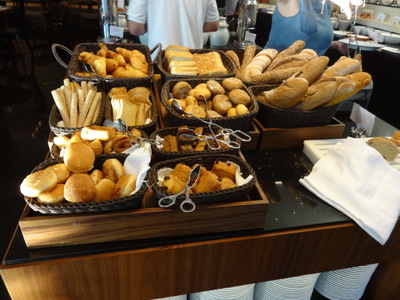
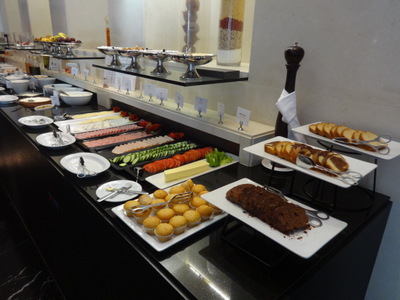 The Aquila Atlantis Hotel's breakfast buffet is a marvel. It starts with the array of breads and pastries in the left-hand photo: croissants, raisin buns, pains au chocolat, small filled donuts, sesame-sprinkled puff pastry strips, melba toast, sesame bread sticks, crusty rolls, sliced bread (for the toaster), and an assortment of baguettes and batards from which you could cut off chunks to suit yourself with the large wicked knife on the adjacent cutting board.
The Aquila Atlantis Hotel's breakfast buffet is a marvel. It starts with the array of breads and pastries in the left-hand photo: croissants, raisin buns, pains au chocolat, small filled donuts, sesame-sprinkled puff pastry strips, melba toast, sesame bread sticks, crusty rolls, sliced bread (for the toaster), and an assortment of baguettes and batards from which you could cut off chunks to suit yourself with the large wicked knife on the adjacent cutting board.
Next came slices of three kinds of loaf cake, little sweet muffins, a two-foot-long stick of excellent butter, sliced tomatoes and cucumbers, three kinds of cold cuts (for the GErmans), and three kinds of cheese (gouda, ementhal, and mizithra, which is the local version of ricotta, compressed just until it holds its shape when sliced; yummy with honey for breakfast), and in the silver chalices above, four kinds of local cookie and four kinds of fresh whole fruit.
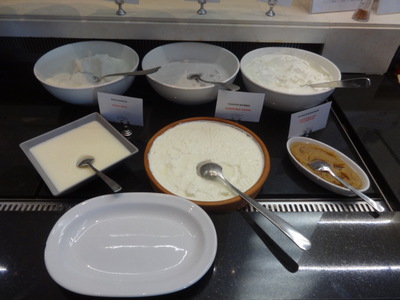
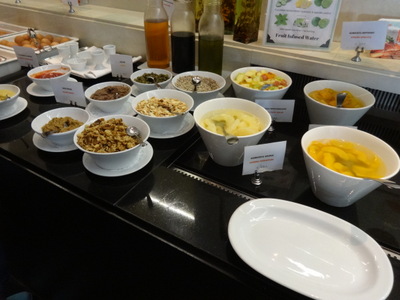 Beyond that, full-fat yogurt, low-fat yogurt, sheep's-milk yogurt, "vanilla cream," and a sticky, brownish, sweet paste of semolina cooked in sugar syrup. I don't know what was in the sixth dish. The full-fat yogurt topped with a little thick local honey was outstanding.
Beyond that, full-fat yogurt, low-fat yogurt, sheep's-milk yogurt, "vanilla cream," and a sticky, brownish, sweet paste of semolina cooked in sugar syrup. I don't know what was in the sixth dish. The full-fat yogurt topped with a little thick local honey was outstanding.
Then three kinds of canned fruit and one dish of mixed chopped fresh fruit, then six bowls of things to sprinkle on other stuff: walnuts, toasted almonds, sunflower seeds, capers, and green and black olive pastes. And three bottles of herb-infused olive oil.
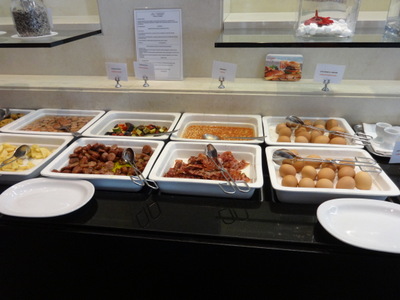
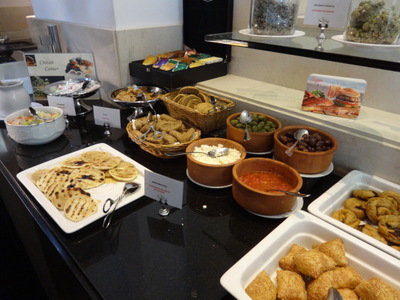 And it kept on going. AFter big bowls of ketchup and mustard came hot four-minute eggs and hot eight-minute eggs, bacon, baked beans (for the Brits), chopped roasted vegetables, chunks of two kinds of sausage, fried potatoes, and (just out of sight to the left), a couple of kinds of cheese-stuffed bread.
And it kept on going. AFter big bowls of ketchup and mustard came hot four-minute eggs and hot eight-minute eggs, bacon, baked beans (for the Brits), chopped roasted vegetables, chunks of two kinds of sausage, fried potatoes, and (just out of sight to the left), a couple of kinds of cheese-stuffed bread.
Beyond that came bowls of green and black olives, and baskets of barley rusks to be topped with the chopped tomatoes and crumbled feta in front of the olives. The round objects with grill marks, drizzled with honey, were labeled "traditional Cretan pie with cheese"; I haven't tried them yet. Beyond those are a chalice of Turkish delight (and, one day, slabs of chocolate-marbled halvah) and a china bowl of pickled vegetables.
The egg station didn't photograph well, but it offered scambled eggs (excellent, even out of a chafing dish), hot poached eggs, sunny-side-up fried eggs, and a chef ready to cook you a custom omelet.
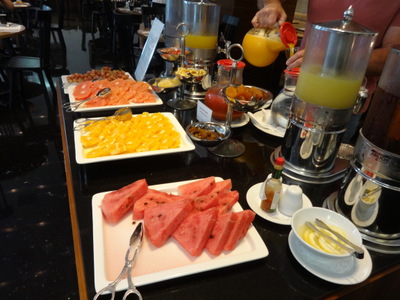
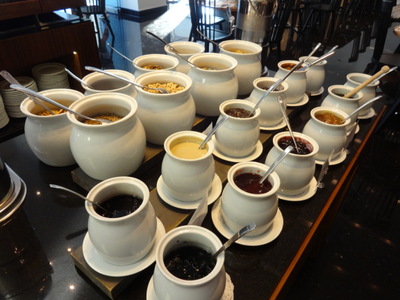 Just two more tables to go. Here, at the left, is the fruit service: slices of watermelon, white melon (off being refilled when I took the photo, oranges, red grapefruit, and grapes, plus dried bowls of dried papaya, banana, pineapple, apricots, and raisins. A bowl of lemon slices, a botle of tabasco, and a pepper shaker are also supplied.
Just two more tables to go. Here, at the left, is the fruit service: slices of watermelon, white melon (off being refilled when I took the photo, oranges, red grapefruit, and grapes, plus dried bowls of dried papaya, banana, pineapple, apricots, and raisins. A bowl of lemon slices, a botle of tabasco, and a pepper shaker are also supplied.
Behind the cut fruit is a row of coolers dispensing several fruit juices and chilled water (yes, you can drink the water, right from the tap).
Finally, this forest of urns was filled with eight kinds of dry cereal and granola (flanked by big metal dispensers of full-fat and skimmed milk) and, on the near side, jams, jellies, marmalades, tahini, honey, nutella, and stewed prunes.
While you fill your plate (and they provide big plates (as well as large and small bowls, glasses, and egg cups), the waitress takes your drink order. I alternate between tea (choose your own flavor from the chest on the buffet) and excellent café au lait, which I make by ordering a pot of decaf and a pitcher of hot milk, which I mix myself. You can also get hot chocolate and cold coffee drinks.
Now that's a breakfast. About Wednesday, the kitchen and management seemed to catch on that the crowd included many Americans. Peanut butter appeared on the buffet, with the jams and honey, and Whitney Houston, Wailing Woman, cultural imperialism personified, joined the muzak rotation.
After breakfast, David needed to practice his talk, then he wanted to take a nap—he hadn't slept as well as we usually do after our first couple of days of tourism, and we'd had a couple of late nights. I therefore hung out in the room, working on this diary, until we went to lunch. We decided to stay in the hotel to see if the lunch was as good as the breakfast, but to our surprise, when we showed up at 12:55 p.m., we had to wait another 5 minutes for the restaurant to open. Françoise says that lunch is routinely somewhere between 1 and 3 p.m., depending on when you want to start your siesta. Stores and businesses close for most of the afternoon, and the city gets very quiet until everything starts reopening about 5 p.m.
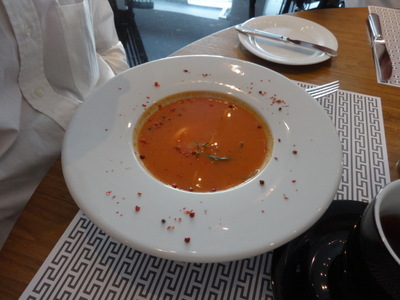
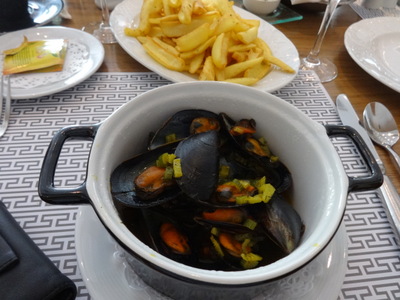 We wanted something small, so we ordered from the appetizer menu. David chose gaszpacho, which always astounds me. For somebody who loathes cucumber (and claims it upsets his digestion) and dislikes raw onion or garlic, he consumes an amazing amount of gaszpacho, with enjoyment and without later complaint. Go figure.
We wanted something small, so we ordered from the appetizer menu. David chose gaszpacho, which always astounds me. For somebody who loathes cucumber (and claims it upsets his digestion) and dislikes raw onion or garlic, he consumes an amazing amount of gaszpacho, with enjoyment and without later complaint. Go figure.
I got the mussels with white wine and fennel and a side of fries. They came in the usual covdered pot in which mussels are steamed, sitting in the usual pool of liquid strewn with bits of fresh fennel, but each one was on the half-shell, and they had clearly been broiled lightly at some point after steaming. Very good, but definitely different—more dried out and chewier, though very flavorful. The fries were excellent and completely different from the ones at breakfast—they were cut in that odd shape (U-shaped in cross section) that we first encountered in Burgundy years ago. Very hot and crispy.
Colleague John Fleeger joined us, but I didn't get a photo of his meal, and I'm afraid I don't remember what he ordered.
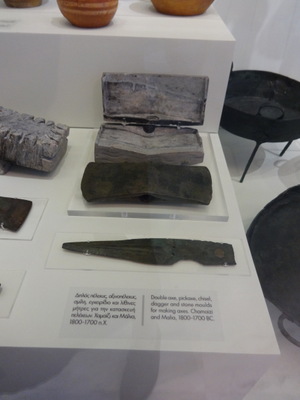
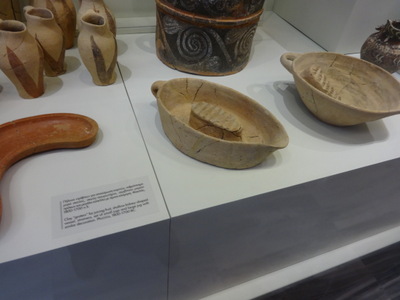 Next on the agenda was the Archeological Museum of Crete, just a block from our hotel (although it's so large that you have to walk three blocks to get around to the front entrance).
Next on the agenda was the Archeological Museum of Crete, just a block from our hotel (although it's so large that you have to walk three blocks to get around to the front entrance).
Photography was allowed, except in rooms displaying material that had not yet been published (fair enough). As usual, the preponderance of the artefacts were stone or clay jars and containers. And as usual I gravitated to interesting cooking implements. At the left here is a stone mold used for casting metal axe heads.
At the right are a couple of "fruit graters." Tomatoes didn't show up until after Columbus, so I guess the ancient Cretans grated soemthing else to top their rusks with. Maybe peaches would be good, topped with grated feta.
I was also taken with a small clear glass bottle, shaped like a lidless tea pot but with the handle on the side rather than opposite the tiny spout. It was labeled "feeding bottle"; an early take on the baby bottle!
Oil lamps were common, but less frequent were multi-spouted ones, like candelaubras, I guess. Some had just two or three spouts, but one was shaped like a foot-wide birdbath with a whole circle of little spouts around the sides for wicks.
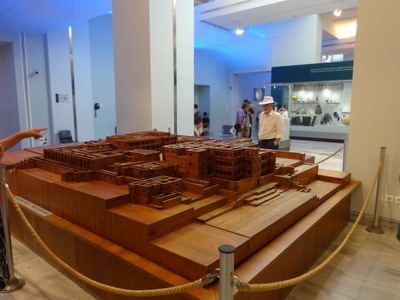
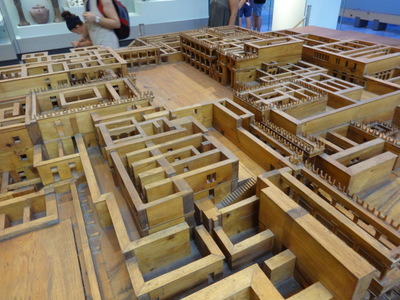 A highlight of the museum is this wooden scale model of the Knossos palace, center of the long-lived and highly developed Minoan culture. (I learned just now, in a cultural talk interspersed with the meiofauna stuff, that the Minoan culture was wiped out around 1400 BC by a gigantic volcanic eruption on a nearby island that first scorched half of Crete and then tsunamied it thoroughly. While the Minoans were reeling, the Myceneans invaded and took over.) The palace is considered the highlight of Cretan tourism, but we're unlikely to have time to visit it. David was there years ago when he came to Crete for some other meeting.
A highlight of the museum is this wooden scale model of the Knossos palace, center of the long-lived and highly developed Minoan culture. (I learned just now, in a cultural talk interspersed with the meiofauna stuff, that the Minoan culture was wiped out around 1400 BC by a gigantic volcanic eruption on a nearby island that first scorched half of Crete and then tsunamied it thoroughly. While the Minoans were reeling, the Myceneans invaded and took over.) The palace is considered the highlight of Cretan tourism, but we're unlikely to have time to visit it. David was there years ago when he came to Crete for some other meeting.
The left-hand photo is an overview of the whole model and the left-hand one a closer shot looking down into the central courtyard.
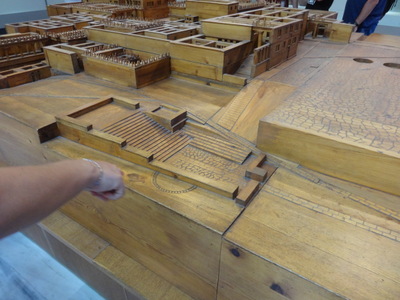
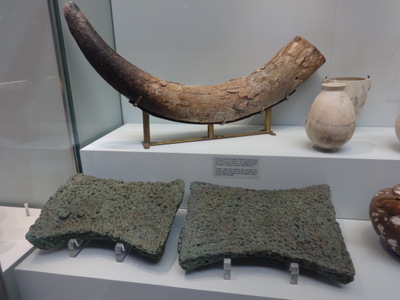 At the left here is a shot of the far side of the model, showing the outdoor theatre in the side yard.
At the left here is a shot of the far side of the model, showing the outdoor theatre in the side yard.
The photo at the right shows two important imports to Crete in ancient times: elephant tusks for ivory and copper ingots for making copper and bronze implements (they had no iron at the time). Many copper ingots were on display, from different periods, and for some reason they were always this same shape and size. Both the tusks and the ingots were imported from Cyprus and the east. We also saw a ceremonial helmet entirely clad in short, curved boar tusks rather than elephant ivory.
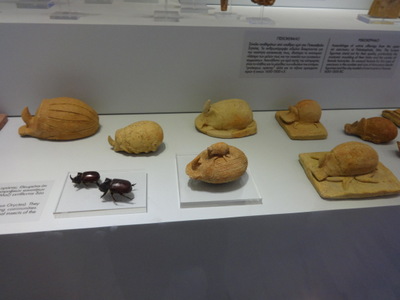
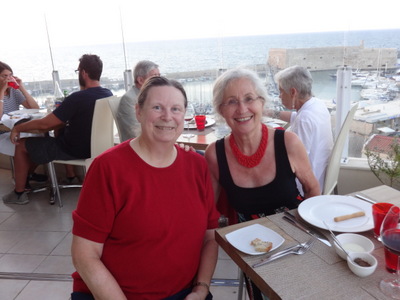 From the display here, I learned that rhinoceros beetles (genus Oryctes) "are related to the beliefs of herding communities." No further information was given, so I don't know in what way.
From the display here, I learned that rhinoceros beetles (genus Oryctes) "are related to the beliefs of herding communities." No further information was given, so I don't know in what way.
As you can see, the museum has a large collection of clay rhino beetle figurines of various styles, which they display together with two real beetle specimens for comparison.
Nearby were some charming, tiny bronze figurines of a very realistic mouse and some other animals.
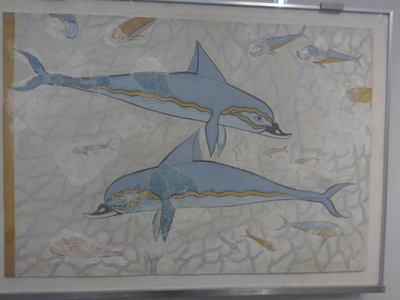
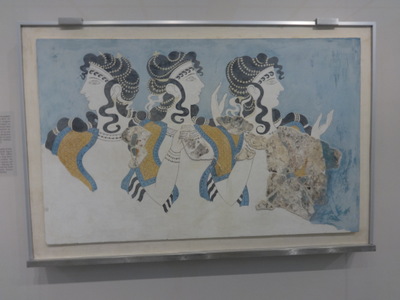 In the large room displaying frescos, we found these two, both pretty heavily restored from small fragments, on the basis of other images from the period. The professor who just lectured on the sea in Minoan art remarked particularly on the dolphins at the left. In general, Minoan artists were extremely accurate in their portrayal of sea creatures (the fisheries scientist sitting next to me was muttering under his breath, identifying them to species on each slide, before the professor could do so), but these are common dolphins, and the only species with a yellow stripe are different altogether and did not occur in this area. The professor speculates that the use of yellow is simply artistic license, but still finds it puzzling. The Myceneans who followed the Minoans, however, were terrible at portraying sea creatures.
In the large room displaying frescos, we found these two, both pretty heavily restored from small fragments, on the basis of other images from the period. The professor who just lectured on the sea in Minoan art remarked particularly on the dolphins at the left. In general, Minoan artists were extremely accurate in their portrayal of sea creatures (the fisheries scientist sitting next to me was muttering under his breath, identifying them to species on each slide, before the professor could do so), but these are common dolphins, and the only species with a yellow stripe are different altogether and did not occur in this area. The professor speculates that the use of yellow is simply artistic license, but still finds it puzzling. The Myceneans who followed the Minoans, however, were terrible at portraying sea creatures.
I found the dancing ladies at the right especially charming.
So we went through every room of the museum, and we looked, at least in passing, at everything, but we certainly didn't do it justice in half a day. We may have to play hooky one day and go back.
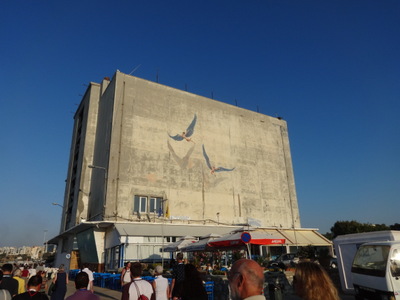
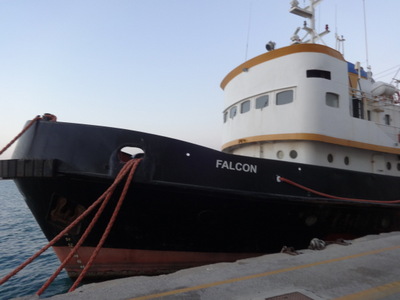 For some time, meeting participants had been asking one another just where the Sunday-night icebreaker social was to occur. The program and website just said "Heraklion Port," but that covered area of several kilometers. I asked repeatedly, by e-mail ahead of time and later at the registration desk, and I got a variety of answers, even after I got it narrowed down to the scenic portion of the old port: (1) At "Enetiko Likani"; it's a well-known location (although, I found, the internet had never heard of it); (2) On the mole next to the fort; (3) Just walk down to the port; you'll easily see the event; (4) On the stone pier across the water from the fort; etc. We even got two different answers as to when it would start!
For some time, meeting participants had been asking one another just where the Sunday-night icebreaker social was to occur. The program and website just said "Heraklion Port," but that covered area of several kilometers. I asked repeatedly, by e-mail ahead of time and later at the registration desk, and I got a variety of answers, even after I got it narrowed down to the scenic portion of the old port: (1) At "Enetiko Likani"; it's a well-known location (although, I found, the internet had never heard of it); (2) On the mole next to the fort; (3) Just walk down to the port; you'll easily see the event; (4) On the stone pier across the water from the fort; etc. We even got two different answers as to when it would start!
So the stage was set for one of those comical mix-ups that plague all meeting organizers. In the end, answer 4 seemed to be gaining in popularity, wo we walked down there on spec, only to find that the boat show stage and food tent still occupied that spot and were clearly gearing up for another show and catered cookout. When the meeting organizers arrived a few minutes later, they were astonished to find that the boat show was there! They telephoned the caterer of our function to ask, "Where are you?!," and then led us all to a spot between the port authority building and a large tugboat (the Falcon, above right), where they had found space to set up.
On the way, we passed this mural on the side of the port authority, which I take to be Icarus and Daedalus setting out for the mainland. Eventually, the shade of the building covered the area, so we only stood in the sun for half an hour or so. A few standing-height tables were set up, but no chairs were provided, so we juggled large china plates and drinks in real glassware while standing around on the stone quay. The food was excellent though (rusks with tomatoes and cheese, two kinds of sliced cheese, artichoke tarts, small slices of roasted pork, little cheese turnovers, little spinach turnovers, sweet cheese tarts, crispy spiral pastries covered with honey and sesame seeds), and so was the conversation with friends and colleagues, so we had a good time anyway and got home in time to go to bed early.
Previous entry
List of Entries
Next entry

 The Aquila Atlantis Hotel's breakfast buffet is a marvel. It starts with the array of breads and pastries in the left-hand photo: croissants, raisin buns, pains au chocolat, small filled donuts, sesame-sprinkled puff pastry strips, melba toast, sesame bread sticks, crusty rolls, sliced bread (for the toaster), and an assortment of baguettes and batards from which you could cut off chunks to suit yourself with the large wicked knife on the adjacent cutting board.
The Aquila Atlantis Hotel's breakfast buffet is a marvel. It starts with the array of breads and pastries in the left-hand photo: croissants, raisin buns, pains au chocolat, small filled donuts, sesame-sprinkled puff pastry strips, melba toast, sesame bread sticks, crusty rolls, sliced bread (for the toaster), and an assortment of baguettes and batards from which you could cut off chunks to suit yourself with the large wicked knife on the adjacent cutting board.
 Beyond that, full-fat yogurt, low-fat yogurt, sheep's-milk yogurt, "vanilla cream," and a sticky, brownish, sweet paste of semolina cooked in sugar syrup. I don't know what was in the sixth dish. The full-fat yogurt topped with a little thick local honey was outstanding.
Beyond that, full-fat yogurt, low-fat yogurt, sheep's-milk yogurt, "vanilla cream," and a sticky, brownish, sweet paste of semolina cooked in sugar syrup. I don't know what was in the sixth dish. The full-fat yogurt topped with a little thick local honey was outstanding.
 And it kept on going. AFter big bowls of ketchup and mustard came hot four-minute eggs and hot eight-minute eggs, bacon, baked beans (for the Brits), chopped roasted vegetables, chunks of two kinds of sausage, fried potatoes, and (just out of sight to the left), a couple of kinds of cheese-stuffed bread.
And it kept on going. AFter big bowls of ketchup and mustard came hot four-minute eggs and hot eight-minute eggs, bacon, baked beans (for the Brits), chopped roasted vegetables, chunks of two kinds of sausage, fried potatoes, and (just out of sight to the left), a couple of kinds of cheese-stuffed bread.
 Just two more tables to go. Here, at the left, is the fruit service: slices of watermelon, white melon (off being refilled when I took the photo, oranges, red grapefruit, and grapes, plus dried bowls of dried papaya, banana, pineapple, apricots, and raisins. A bowl of lemon slices, a botle of tabasco, and a pepper shaker are also supplied.
Just two more tables to go. Here, at the left, is the fruit service: slices of watermelon, white melon (off being refilled when I took the photo, oranges, red grapefruit, and grapes, plus dried bowls of dried papaya, banana, pineapple, apricots, and raisins. A bowl of lemon slices, a botle of tabasco, and a pepper shaker are also supplied.
 We wanted something small, so we ordered from the appetizer menu. David chose gaszpacho, which always astounds me. For somebody who loathes cucumber (and claims it upsets his digestion) and dislikes raw onion or garlic, he consumes an amazing amount of gaszpacho, with enjoyment and without later complaint. Go figure.
We wanted something small, so we ordered from the appetizer menu. David chose gaszpacho, which always astounds me. For somebody who loathes cucumber (and claims it upsets his digestion) and dislikes raw onion or garlic, he consumes an amazing amount of gaszpacho, with enjoyment and without later complaint. Go figure.
 Next on the agenda was the Archeological Museum of Crete, just a block from our hotel (although it's so large that you have to walk three blocks to get around to the front entrance).
Next on the agenda was the Archeological Museum of Crete, just a block from our hotel (although it's so large that you have to walk three blocks to get around to the front entrance).
 A highlight of the museum is this wooden scale model of the Knossos palace, center of the long-lived and highly developed Minoan culture. (I learned just now, in a cultural talk interspersed with the meiofauna stuff, that the Minoan culture was wiped out around 1400 BC by a gigantic volcanic eruption on a nearby island that first scorched half of Crete and then tsunamied it thoroughly. While the Minoans were reeling, the Myceneans invaded and took over.) The palace is considered the highlight of Cretan tourism, but we're unlikely to have time to visit it. David was there years ago when he came to Crete for some other meeting.
A highlight of the museum is this wooden scale model of the Knossos palace, center of the long-lived and highly developed Minoan culture. (I learned just now, in a cultural talk interspersed with the meiofauna stuff, that the Minoan culture was wiped out around 1400 BC by a gigantic volcanic eruption on a nearby island that first scorched half of Crete and then tsunamied it thoroughly. While the Minoans were reeling, the Myceneans invaded and took over.) The palace is considered the highlight of Cretan tourism, but we're unlikely to have time to visit it. David was there years ago when he came to Crete for some other meeting.
 At the left here is a shot of the far side of the model, showing the outdoor theatre in the side yard.
At the left here is a shot of the far side of the model, showing the outdoor theatre in the side yard.
 From the display here, I learned that rhinoceros beetles (genus Oryctes) "are related to the beliefs of herding communities." No further information was given, so I don't know in what way.
From the display here, I learned that rhinoceros beetles (genus Oryctes) "are related to the beliefs of herding communities." No further information was given, so I don't know in what way.
 In the large room displaying frescos, we found these two, both pretty heavily restored from small fragments, on the basis of other images from the period. The professor who just lectured on the sea in Minoan art remarked particularly on the dolphins at the left. In general, Minoan artists were extremely accurate in their portrayal of sea creatures (the fisheries scientist sitting next to me was muttering under his breath, identifying them to species on each slide, before the professor could do so), but these are common dolphins, and the only species with a yellow stripe are different altogether and did not occur in this area. The professor speculates that the use of yellow is simply artistic license, but still finds it puzzling. The Myceneans who followed the Minoans, however, were terrible at portraying sea creatures.
In the large room displaying frescos, we found these two, both pretty heavily restored from small fragments, on the basis of other images from the period. The professor who just lectured on the sea in Minoan art remarked particularly on the dolphins at the left. In general, Minoan artists were extremely accurate in their portrayal of sea creatures (the fisheries scientist sitting next to me was muttering under his breath, identifying them to species on each slide, before the professor could do so), but these are common dolphins, and the only species with a yellow stripe are different altogether and did not occur in this area. The professor speculates that the use of yellow is simply artistic license, but still finds it puzzling. The Myceneans who followed the Minoans, however, were terrible at portraying sea creatures. 
 For some time, meeting participants had been asking one another just where the Sunday-night icebreaker social was to occur. The program and website just said "Heraklion Port," but that covered area of several kilometers. I asked repeatedly, by e-mail ahead of time and later at the registration desk, and I got a variety of answers, even after I got it narrowed down to the scenic portion of the old port: (1) At "Enetiko Likani"; it's a well-known location (although, I found, the internet had never heard of it); (2) On the mole next to the fort; (3) Just walk down to the port; you'll easily see the event; (4) On the stone pier across the water from the fort; etc. We even got two different answers as to when it would start!
For some time, meeting participants had been asking one another just where the Sunday-night icebreaker social was to occur. The program and website just said "Heraklion Port," but that covered area of several kilometers. I asked repeatedly, by e-mail ahead of time and later at the registration desk, and I got a variety of answers, even after I got it narrowed down to the scenic portion of the old port: (1) At "Enetiko Likani"; it's a well-known location (although, I found, the internet had never heard of it); (2) On the mole next to the fort; (3) Just walk down to the port; you'll easily see the event; (4) On the stone pier across the water from the fort; etc. We even got two different answers as to when it would start!